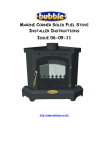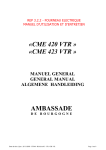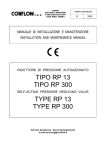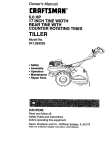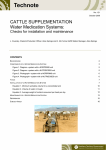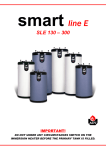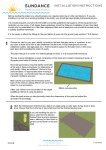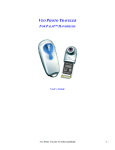Download Rayburn Royal 11-05-04 INSTALLATION INFORMATION
Transcript
Mk 2 PJ. CONVERSION © Rayburn Royal 11-05-04 INSTALLATION INFORMATION © http://www.oilstoves.co.uk/ 1 Contents 1-8. See Separate Document._____________________________________ 4 11. Fitting The Kit._____________________________________________ 4 Remove The Hotplate. __________________________________________ 4 Check The Hot Plate Seal. _______________________________________ 4 Remove The Fuel Loading Door ____________________________________ 4 Remove The Ash pan. ___________________________________________ 4 Remove The Ash pit Base Plate. ___________________________________ 4 Remove The Flue Box Damper Plate. ________________________________ 4 Lock The Air Valve Open. ________________________________________ 4 Seal The Riddling Lever. _________________________________________ 4 Check Firebricks. ______________________________________________ 4 Removing The Firebricks. ________________________________________ 4 Vac The Debris Out.____________________________________________ 5 Fitting The Boards And Burner Components. __________________________ 5 12b. Services Into The Burner. __________________________________ 10 1. Oil Feed. _________________________________________________ 10 2. Oil Isolation Valve. ___________________________________________11 3. Oil Pipework To Pressure Jet Burners. ____________________________11 4. Power In. _________________________________________________ 12 5. Fit the baffle kit.___________________________________________ 12 6. Fit over oven baffle _________________________________________ 12 13. Commissioning. _____________________________________________ 12 1. Setting the Burner Up. _______________________________________ 2. Heat Balancing the System. ___________________________________ 3. Lighting. __________________________________________________ 3.1. To Bleed The Pump. ________________________________________ 3.2. Set The Control Stat. ______________________________________ 3.3. Set The Time Clock. _______________________________________ 3.4. Check The Burner Air Shutter. _______________________________ 3.6. Ignite The Burner._________________________________________ 3.7. Fit The Baffle Box. ________________________________________ 3.9. To Set For Good Combustion. _________________________________ 3.10. Combustion Air. __________________________________________ 3.11. To Adjust The Pump Pressure. ________________________________ 4. Final Checks. ______________________________________________ 4.1. Fuel Tank. _______________________________________________ 4.2. Fuel. ___________________________________________________ 2 12 12 13 13 13 13 13 13 14 14 14 15 15 15 15 4.3. Filter. __________________________________________________ 4.4. Site Glass or Tank Gauge. ___________________________________ 4.5. Oil line. _________________________________________________ 4.6. Fire valves. ______________________________________________ 4.7. Through Wall Sleeving. _____________________________________ 4.8. Isolation valve. ___________________________________________ 4.9. Electrical. _______________________________________________ 4.10. Ventilation. _____________________________________________ 4.11. Chimney System. _________________________________________ 4.12. Check controls Function.____________________________________ 4.14. Vent the Ashpan Door. _____________________________________ 15 15 15 15 15 15 15 15 16 16 16 14. Warranty . _______________________________________________ 16 Items Not Covered Under the Warranty ___________________________ Labour. ____________________________________________________ Travelling time. ______________________________________________ Consequential loss or damage. ____________________________________ Nozzles. ___________________________________________________ Baffle kits and Insulation Boards. _________________________________ Damage to the Fuel Pump. _______________________________________ 17 17 17 17 17 17 17 15. Fault Finding. _____________________________________________ 17 16. Servicing. ________________________________________________ 17 18. Illustrations_______________________________________________ 17 Fig 27 Sectional Details ________________________________________ 18 Fig 28 Board Details __________________________________________ 18 Fig 29 Grind Door ____________________________________________ 19 Oven Stat Details ____________________________________________ 19 Fig 30 Oven stat sensing position. _________________________________ 20 Fig 31 Wiring and control layout __________________________________ 20 Wiring Diagrams (All stat details) _________________________________ 21 Chimney terminal details. _______________________________________ 22 19. Parts and packing list _______________________________________ 23 3 LOCK THE AIR VA LVE OPEN. 1-8. SEE SEPARATE DOCUMENT. Fully open the spin valve which is located in the ash pan access door and lock it permanently in this position by use of either a lock nut, or a (suitably positioned) drilled hole and split pin. 11. FITTING THE KIT. REMOVE THE HOTPLA TE. CHECK THE HOT PLA TE SEA L. It is essential that as much cooling and combustion air as possible be allowed to circulate around the burner. Make sure that the ceramic rope seal, on to which the hotplate sits, is in good condition and not over compressed, if it is not forming a good airtight seal with the closure plate, renew it. A permanent free air supply must be established, as the burner cannot function without it. REMOVE THE FUEL LOA DING DOOR Remove the fuel-loading door and then remove the cast iron protection plate on the inner side of the fuel-loading door. SEA L THE RIDDLING LEVER. (It may be necessary to drill the heads of the fasteners off and remove the stubs with Stilsons) CHECK FIREBRICKS. Push the riddling lever fully in and apply fire cement to the mechanism to prevent any further movement. Check on the condition of the, sham (opposite oven) side firebricks and if necessary replace the upper one, a new lower one comes in the board kit supplied with the conversion. When the lining plate is removed clean the door inner surface. REMOVE THE ASH PA N. REMOVING THE FIREBRICKS. REMOVE THE ASH PIT BA SE PLA TE. Remove the thick front firebrick beneath the fuel-loading door. This is generally held in place by a single fastener in he front centre of the plate. (This is a time consuming job, don't rush and take care not to apply too much pressure as the front casting of the appliance is only thin and can be easily broken.) Clean and vac out under it. REMOVE THE FLUE BOX DA MPER PLA TE. Remove the sliding damper in the flue box and seal the opening left by the sliding damper with fire cement. Remove the oven side bricks. Remove the lower sham (opposite oven side) side brick and this will then allow access to the cast iron plate fitted over the riddling grate, which can now be removed. 4 Fig 1 Ashpit Base Remove and Clean Shows bricks and riddling grate removed but the cast iron grate carrier still in place Fig 3 FITTING THE BOA RDS AND BURNER COMPONENTS. Fig 2 Shows the oven side castings, riddling grate, ashpit base and the grate carrier removed. Before permanently fitting the boards, try a dummy run, to make sure everything fits before final permanent fitting and fire cementing. It may be necessary to trim some of the boards to fit. Fit Ash pit Base Oven Side Lining Boards These boards will have to be cut out to the dimensions on the drawing supplied. Fig 4 VA C THE DEBRIS OUT. Thoroughly vacuum out all the dust and debris. from the appliance, the ash pan area must be free from all traces of ash. 5 Fit Closure Plate The closure plate is fitted with the angles down and the burner hole offset to the rear of the appliance. Fig 6 Use silicone to attach the boards to the side castings. Fit Closure Plate Support Boards Fig 5 The closure plate has retaining angles attached to the underside, these are used to hold the support boards in situ. View from above showing closure plate fitted with offset to the rear of the appliance. Fig 7 These are held in place by the angle brackets on the underside of the closure plate. 6 Fit Primary Closure Plate Cover Board Fig 10 Fig 8 Fit the two pieces of 200 mm long x 20 mm dia rope at the front and rear of the primary closure plate board to fill the gaps. Fit Side Boards and Secondary Closure Plate Board This photo does not show the sham side bricks in situ. but they must be fitted. Make sure that the holes in the closure plate boards are concentric to the hole in the closure plate. Fig 11 Fit Primary Front Board Fig 9 Trim out the face of the board to accommodate any casting or fastener protrusions to make sure that it fits snugly up to the front casting. 7 Fit Secondary Front Board Using the viewing glass as a template, mark a further concentric circle around the 60mm hole. Fig 12 Using a sharp chisel, countersink a flat bottomed recess, to accept the depth of the glass. Silicone the glass panel into the socket and screw the stainless cover plate to the front board to sandwich the glass panel into place. Neatly seal around the edge of the stainless cover plate with silicone to finish off. When the secondary front board is fitted, fix it to the front board by the use of 4 x 35mm wood screws. Screw through from the front board into the secondary board. Fig 14 Fit the stainless angle plate with two screws up to the inner front board. Fig 13 Fit Burner Base Plate With Fan Attatched Fig 16 Fit the fuel loading door access cover plate and use it as a template to mark the centre of the viewing port. Remove the plate and drill through with a 60mm diameter hole saw. 8 The burner base plate has a levelling screw in each corner, make sure that the plate sits flat on the base of the cooker. Fig 19 Push the burner base plate tight up to rear left hand side of the ashpit base. Fit Combustion Head with the high pressureflexi oil pipe fitted and connect the Air Hose Fig 17 The upper support plate is fastened to the burner base plate by two M5 fasteners. It is pushed up to the right hand side of the ash pit and used to support the pump and control module and also lock the whole assembly in place. Fit Fuel Pump Fig 20 Fig 18 View from under side of closure plate Fit the fuel pump and connect the flexi oil feed to the solenoid outlet. Fit Upper Support Plate 9 Fig 21 Tighten the fuel hose. Fix in place with 2 x M5 fasteners. WHEN YOU ARE HAPPY WITH THE DUMMY RUN, PROCEED AND FIT EVERYTHING PERMANENTLY, FIRE CEMENTING THE BOARDS IN PLACE AND FILLING ANY GAPS WITH FIRE CEMENT OR ROPE AS YOU GO. 12B. SERVICES INTO THE BURNER. 1. OIL FEED. Fit Control Module To get the oil feed pipe work through the side of the appliance it will be necessary to mark out and drill through the inner and outer skins of the appliance, this is an awkward job requiring some patience. 2 x M5 fasteners. Fig 22 Hole saw through the outer panel and then self tap the adaptor plate to the side panel. Mark through onto the inner cast iron panel and drill through to gain access for the oil feed, power, and stat link. The KBB fire-valve phial will have to fitted on the inside of the ashpit door via a suitable clip. Before fastening the control module onto the upper support plate connect-: The ashpit door cast sealing face will have to be ground away to provide access for the phial capillary. 1. HT leads 2. The fan motor connector Note to make the drilling easier, drill a small pilot hole first and follow through with a larger diameter drill. 3. The fuel pump connector 4. The solenoid connector 5. Plug the Photo Cell into the combustion head. Lay the connected wiring as neat as possible. 10 Fig 23 Fig 25 Adaptor plate fitted 4 3 6 2 1 5 7 Fit the flexi oil feed pipe and the remote fire valve phial and capillary through the cable support in the lower plastic plug ready to connect up. Fig 24 is a view showing access holes drilled through the inner casting. 2. OIL ISOLA TION VA LVE. Fig 24 Fit the oil isolation valve prior to the KBB firevalve. 3. OIL PIPEW ORK TO PRESSURE JET BURNERS. Fig 26 Fig 25 is a view showing some critical items 1. Power in plug 2. Oil bleed tap 3. Flexi air hose. Because there is a motor and a fan in the burner unit, some vibration may be transmitted through the pipework. 4. Fuel pressure test point 5. Fuel pressure adjuster screw. 6. Controller lock out reset button. 7. Thermostat live link out. 11 If the pipework is in contact with any sharp edges fretting can occur, to prevent this apply silicone sealant at any potential hazard points. 6. FIT OVER OVEN BA FFLE Left hand oven shown. Check that the oil supply line has a suitable filter, firevalve and does not have the potential for air locking. 4. POWER IN. Fit the mains feed cable through the cable support ready to connect up to the plug supplied. 13. COMMISSIONING. 5. FIT THE BA FFLE KIT. The baffle kit comprises of two components. Commissioning takes the form of three separate activities-: 1. A circular stainless steel tube with a ceramic board lid and cut outs in the vertical sides of the tube. 1. Setting the burner up. The cut outs allow hot gasses to be directed to the oven side and boiler side. 3. Final check of the complete installation. 2. Heat balancing the appliance to the users system. 1. SETTING THE BURNER UP. It is fitted concentrically over the flame tube and the spikes are pressed down into the top board to prevent movement. 1a. Nozzle .4 x 60 Deg solid 1b. Pump Pressure 9 Bar 1c. Gross Output 17 kW It can be rotated to a variety of different positions relative to the users requirements. 1d. Net Output 9kW 1e. Flue Gas Flow .0027 m/s. 2. A simple angle plate designed to stop the flue gasses going diagonally across the oven top and directly up the chimney. 2. HEA T BA LA NCING THE SYSTEM. The plate is fitted in the right angle corner of the hot plate cut out closest to flue outlet; it diverts the flue gasses towards the front of the appliance and then out of the appliance. If there is no boiler fitted then adjust the baffle to get the balance between the hot plate and oven. Adjusting the position of the round baffle to give the correct distribution of heat between the boiler and oven. 12 3. LIGHTING. 6. Put plenty of tissues around the bleed tap and ask your assistant to turn the power on but be ready to turn it off quickly. Make sure the appliance is fully assembled , do not fit the baffle box as it is necessary to view the flame. 7. Turn the power on and watch until oil is vented off through the tap. Carry out electrical safety tests in line with IEEE and OFTEC requirements Polarity. When this occurs quickly power off and tighten the bleed tap. Short circuiting. Mop up any spillage. Earthing. 3.2. SET THE CONTROL STA T. Turn the oil on and check for oil leaks. Turn the stat fully off . 3.1. TO BLEED THE PUMP. Make sure that the time clock is calling. 3.3. SET THE TIME CLOCK. 1. Take great care when bleeding the pump, It is a single cylinder reciprocating device and if repeated lockouts occur, due to lack of fuel caused by air locking, it can soon be damaged. 3.4. CHECK THE BURNER AIR SHUTTER. The burner air shutter has been set at the factory and should be satisfactory for test firing. If the pump runs without oil it will make a quite loud and rapid rattling noise and permanent damage in the form of a subdued rattling will occur. To adjust the burner air the control module will have to be eased out of the ashpit to allow access for you hand into fan assembly. 2. Turn the oil on and make sure that the isolation valve and KBB fire valve are turned into the on position. The air slide is locked in place with a m5 plastic headed screw on the side plate. 3. Turn the operating stat down so that it is not calling. 3.6. IGNITE THE BURNER. The viewing port is pluged with ceramic wool which should be removed to view the flame during commissioning and replaced after. 4. Go to the burner and undo the bleed tap 2 Fig 25. 5. You will need an assistant to turn the power on and quickly off at your command. Turn the stat ON and viewing through the port you will see the burner go through an ignition sequence and ignite. 13 Failure to ignite will cause the flame failure button on the controller to illuminate, after a short time push the button in to reset the controller and repeat the process again until ignition occurs. Coupled with this, these appliances are not air tight and further air will ingress into the flue gasses. 3.7. FIT THE BA FFLE BOX. If you do attempt to take flue gas readings, wait until the burner has been running for at least three quarters of an hour after which time you should check that the flue vacuum conforms to our stated requirements. The best plan is to use a smoke pump and set the burner at between 0-1 smoke. When you are happy with the flame picture, turn the burner off and isolate the mains electricity before you fit the baffle box. Make sure that the baffle is set up to suit the users requirements. At a position about 18” above the flue box, drill a test point hole in the flue pipe large enough to insert your analsys probe. The baffle is fitted over the flame tube as illustrated. There are two rectangular cut outs in the vertical sides of the baffle which can be positioned to point to -: With a flue vacuum of between .02" &. 05" w.g., the following analysis results should be obtained: - 1. The rear and left hand side for intensive water heating or wintertime running Smoke between 0 and 1 CO = Less than 100 ppm Or CO2 = Between 7 and 8% 2. The front and right hand side for intensive cooking or summer time running. O2 = 5 - 6% . (note that you may get a reading well in excess of this figure) Or Flue gas temperature will vary greatly depending upon the oven temperature. 3. To the right and rear for intermediate running. After analysis readings have been taken make sure that you fit a suitable plug into the test point hole. It can be set up to bias the flame to the oven or the boiler or an intermediate position. 3.10. COMBUSTION AIR. Combustion air is adjusted via the air control damper on the fan unit which when set can be locked in place. 3.9. TO SET FOR GOOD COMBUSTION. Because of the oven vent allowing excess air into the flue gasses it will be difficult to take accurate flue gas analysis readings. 14 Because the burner is a tight fit in the ashpit area it will be necessary to ease the control module out of the ashpit on to a suitable temporary stand to allow access in to adjust the air slide. 4.1. FUEL TA NK. 3.11. TO ADJUST THE PUMP PRESSURE. 4.3. FILTER. Check for leaks-stability-heightposition-vent. 4.2. FUEL. Fuel- check for correct grade Is it fitted? There are two type of pump fitted to Flexaflame burners. Check for function and leaks. 4.4. SITE GLA SS OR TA NK GA UGE. Nippon and Taisan Check for function and leaks. The oil pump pressure on the Nippon pump is adjusted via the screw to the left of the fuel entry position. The burner is set at the factory at a pressure to suit the appliance being converted. 4.5. OIL LINE. Check for function, positioning, material suitability and leaks. Make sure that a leak test is carried out after the burner has been running for at least half an hour, make sure that there is no oil dripping from the combustion head. Fully in and three quarters of a turn out is equal to 10 Bar, each quarter of a turn out is equal to one bar reduction. If you lose your position with the adjustment, get back to the 10 bar start point. 4.6. FIRE VA LVES. Check for function and leaks. Taisan 4.7. THROUGH WA LL SLEEVING. The oil pump pressure on the Taisan pump is adjusted via the setscrew and locknut to the Right of the fuel entry position. Check that it is fitted and sealed 4.8. ISOLA TION VA LVE. Check for function, convenience of positioning and leaks. The burner is set at the factory at a pressure to suit the appliance being converted. 4.9. ELECTRICA L. Check for correct fusing, location and specification of any isolation devices. 4. FINA L CHECKS. Commissioning checks should be carried out on the following-: 4.10. VENTILA TION. Make sure that adequate ventilation is provided. 15 4.11. CHIMNEY SYSTEM. This will have a beneficial effect on the longevity of the burner as it will be operating in a much cooler environment. Chimney system should be checked to make sure that it complies with the relative standards, regulations and all other instructions given. The door should be removed and placed upon a bubble pack support to prevent damage to the enamel surface. 4.12. CHECK CONTROLS FUNCTION. Check correct hot condition functioning of water heating system and all controls. Using a 4inch disc grinder set up with a flap wheel, grind away an area as detailed in Fig 13 and refit the door. 4.13. Instruct User. Ensure that the customer is instructed on the basic use of the appliance, timers, controls and oil / electrical isolation devices if fitted. 14. WARRANTY . Ensure that the warranty registration documentation is returned to The importance of regular maintenance and regular checking for oil leaks. Harworth Heating Ltd. It will not be possible to deal with any warranty claims unless we hold on our Data Base, details from a correctly filled in warranty commissioning form. Commissioning should not be signed off unless the commissioning engineer is satisfied that all the work done complies with the relative standards and regulations detailed within this document. The form must arrive back at our works within two weeks of the burner being correctly commissioned. 4.14. VENT THE ASHPA N DOOR. When the warranty form is received at our works details from it will be entered on to our warranty registration Data Base. This work should not be carried out unless the customer is 100% happy with the conversion. This information will form part of a record of the installation and will be the first point of reference by our staff, for any claims made under the equipment warranty. Once the work has been carried out it is not possible to convert the appliance back to solid fuel, should the need ever arise. The objective of the activity is to allow a cooling stream of air to pass vertically up behind the ashpit door and stop the build up of hot air in the ashpit. 16 The warranty covers PARTS ONLY for a period of ONE YEAR and is conditional upon all the requirements of our installation and commissioning instructions being fully adhered to. Schedules will also be available from our web site. ITEMS NOT COVERED UNDER THE WA RRA NTY Additional information follows in the form of illustrations www.oilstoves.co.uk 18. ILLUSTRATIONS LA BOUR. TRA VELLING TIME. CONSEQUENTIA L LOSS OR DA MA GE. NOZZLES. BA FFLE KITS A ND INSULA TION BOA RDS. Damaged due to faulty installation and or faulty commissioning of the appliance. DA MA GE TO THE FUEL PUMP. Caused by air locks in the fuel line or lack of fuel. If the fuel pump runs without oil it will make a loud and rapid rattling noise. If this occurs permanent damage in the form of a subdued rattling will occur. 15. FAULT FINDING. Fault finding procedures are covered under a separate sheet. 16. SERVICING. Servicing should be Carried out at six monthly intervals Service engineers should request a copy of the servicing schedule from our sales desk. 17 FIG 27 SECTIONA L DETA ILS FIG 28 BOA RD DETA ILS 18 FIG 29 GRIND DOOR OVEN STA T DETA ILS The oven stat is wired in series with the water stat (if it is fitted) and mounted in a plastic enclosure fitted to the top, opposite oven, side panel. Note (A water stat would be fitted if the appliance has a hot water boiler fitted, if the appliance does not have a water boiler then an oven stat only would be required.) The installer has to drill a 5mm dia hole in the top front corner of the appropriate panel(Cookers can be right or left hand oven.) to allow the phial and capillary to be fed across the fuel loading door opening and into the oven via the top front corner. The front cover shows a left hand oven cooker with the oven stat fitted on the upper left hand panel. The phial is held in place by the small stainless steel bracket provided The oven stat has a sensing bulb and a small diameter capillary tube which should be carefully unwound and neatly fitted, making sure that the capillary tube and bulb cannot be bent, trapped or damaged. Remember damage to the tube or bulb will prevent the thermostat from functioning. Obviously the bulb is fitted in a support bracket at the front of the oven as illustrated below in Fig 30. The capillary runs across the front of the appliance through a guide tube located across the front of the refuelling door. 19 Care must be taken when fitting the guide tube which is positioned so as to allow the subsequent, convenient replacement of the stat should it ever fail. The bundi guide tube is fitted into a trough, which the installer has to cut into the rear of the primary front board. Note FIG 30 OVEN STA T SENSING POSITION. This photo shows the oven stat mounting bracket fitted in the top front of the oven. The cooker in the picture is a Rayburn Supreme. FIG 31 WIRING A ND CONTROL LA YOUT 20 WIRING DIA GRA MS (ALL STA T DETA ILS) 21 CHIMNEY TERMINA L DETA ILS. 22 19. PARTS AND PACKING LIST Item No Description PART NUMBER Qty Check 1 Burner assembly complete 77-01-100 1 2 Circular Baffle Kit complete 87-01-001/B 1 3 Closure plate with fasteners 87-18-100/1 1 4 Sight Glass Plate Assembly 87-18-100/6 1 5 Over oven baffle 87-01-001/OB 1 6 Stainless Angle support plate 87-17-010TP 1 23 7 Cable entry plate 87-18-100/7 1 8 Fire valve bracket 87-18-100/8 1 9 Boxed oven stat assembly inc phial bracket 77-01-005/F 1 10 Clip on pipe stat assembly 77-01-005/A 1 11 Long Life Flexi oil supply pipe 1/8” 87-18-100/108 1 12 Fire Valve 77-07-004/G 1 13 Cable Strain for fuel supply 77-01-023 1 14 Cable strain for electrical supply RS392-056 1 15 20mm dia x 200mm long ropes 77-01-928 4 16 Self tapping screws 14 17 Fan connection cable extension 300mm M/F 1 18 Primary Front Insulation Board 87-19-100/1 1 19 Secondary Front Insulation Board 87-19-100/2 1 20 Over closure plate boards 87-19-100/3 2 21 Closure plate support boards 87-19-100/4 2 22 Primary closure plate board 87-19-100/5 1 23 Secondary closure plate board 87-19-100/6 1 24 Oven side ashpit boards 87-19-100/7,8 3 &9 25 User instructions 1 26 Installer instructions 1 27 Flexaflame service burner book 1 © HARWORTH HEATING LTD 05-08-03 This publication may not be copied by any means, without written permission from the authors. 24 This product is subject to continuous development and improvement and it is consequently acknowledged that due to this process there may be some omissions and errors. This publication is intended only to assist the reader in the use of this product and therefore Harworth Heating Ltd shall not be liable for any loss or damage whatsoever arising from the use of any information, error or omission found in this guide. Only approved personnel, WHO HAVE BEEN SUITABLY TRAINED, may carry out maintenance on this product. 25


























